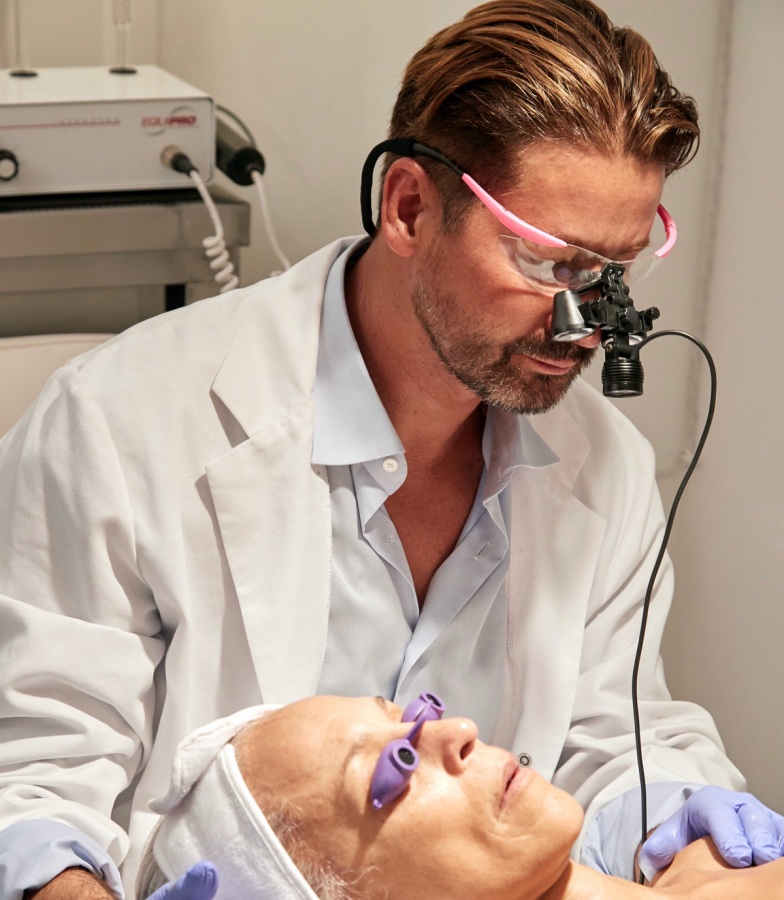
X

Blog
2020-02-11

Did You Know... Vitals Facts About Your Skin and Age Management

Did you know… Your skin is your body’s largest immune system organ?
Every time anything comes in contact with the skin, there is a complex reaction that involves the Langerhans cells. These cells exist only the surface of the skin and protect you by keeping dangerous microbes from entering your body. The Langerhans cells are your body’s the first line
of defense and when they sense any kind of danger, they start the immune response.
Therefore: Any new product is a trigger, technically a stressor, to the immune system of the skin.
It will take time for your skin to accept any new ingredient.
In my experience, when a new product is applied and the skin appears more firm, it is really a clinical irritation causing minor swelling of the skin. Longer use of a topical product — three to six months —is necessary to univocally establish if there a real firming effect due to the presence of more and new fibers in the dermis.

Did you know… Ingredient lists do not really reflect what a product is delivering?
The INCI (International Nomenclature Cosmetic Ingredient) list is not a real indicator of what is being delivered to your skin. Surprising isn’t it?
The list states which ingredients have been mixed during the production process. Inevitably, these molecules react with other molecules, are exposed to variation in temperature through processing, resulting in new components.

Did you know… SPF ratings give no information about the free radical-quenching ability of the product?
SPF ratings are reflective of how long a person can be exposed to light before their skin becomes red (Minimal Erythema Dose). The SPF number has nothing to do with the ability of any product to protect from UV ray-induced damage. Some products may, for example, have a high SPF number but the molecules used to obtain the SPF rating may increase the free radical productions in the skin.

Did you know… High-quality cleansers that benefit the skin are very hard to find?
High quality, well-formulated hydrating face cremes, serums and eye cremes are not difficult to find — they’re practically everywhere, especially those pro-only brands offered only by doctors and licensed skincare professional. But cleansers are almost always neglected.
Because the size of the packaging, and the product needed, is large compared to other treatments, producers often skimp on ingredients when developing cleansers. Therefore most of facial cleansers are, in my professional opinion, quite awful for the skin.
A low quality cleanser seems a small detail to you. Not so: I draw a parallel to tiny bottles of hotel shampoo. Even fancy designer labels or the ones scented with sophisticated designer refined scents are notoriously cheap when it comes to the core ingredients. I am sure everyone
has experienced how using hotel shampoo just one time affects your hair for weeks to come, making it dry, fizzy and unmanageable no matter which nourishing or hydrating products are applied later.
The same happens to your skin: a poorly formulated cleanser can bring main alterations of the skin mantle (your “NMF” or Natural Moisturizing Factor), essentially destroying the main protective and hydrating barrier. This leads to dryness, impaired barrier function, irritation from
other topical products, redness and even post-inflammatory hyper-pigmentation.

Did you know… Drinking water has nothing to do with hydrating your skin?Drinking water is beneficial for your overall health, mood and the tightness of your body. But the dryness you experience on your facial skin but has very little to do with your liquid intake.
Proper maintenance of the skin is insured by two main factors: the quantity of hygroscopic molecules in the dermis and the integrity of the very delicate skin barrier know as the “NMF” (the Natural Moisturizing Factor).
Hygroscopic molecules are linked to exposure to the light and a diet rich in Vitamin C and Amino-acids. It’s how your skin cells attract and maintain moisture. Your NMF is maintained by proper dietary intake and absorption of essential fatty acids and the use of high quality, wellformulated cleansers and toners.
Did you know… Vitamin C-based products are indispensable for any skin type and age.
After zinc or titanium-based SPF sun coverage and a high quality cleanser, Vitamin C products are the most important additions to your routine for glowing skin.
Molecules of L-ascorbic acid, the purest form of vitamin C, are indispensable for the production of protein fibers in the skin. The same molecule acts as an anti-oxidant, protecting skin from free radical damage associated with the sun.
Therefore, everyone should use a day serum and/or creme with correctly formulated, highly biochemically active Vitamin C (see blogs on Vitamin C “Goodness Inside and Out” and “Get Glowing”).
Every time anything comes in contact with the skin, there is a complex reaction that involves the Langerhans cells. These cells exist only the surface of the skin and protect you by keeping dangerous microbes from entering your body. The Langerhans cells are your body’s the first line
of defense and when they sense any kind of danger, they start the immune response.
Therefore: Any new product is a trigger, technically a stressor, to the immune system of the skin.
It will take time for your skin to accept any new ingredient.
In my experience, when a new product is applied and the skin appears more firm, it is really a clinical irritation causing minor swelling of the skin. Longer use of a topical product — three to six months —is necessary to univocally establish if there a real firming effect due to the presence of more and new fibers in the dermis.
At the Christopher Ardant Centers, we keep in mind that is going to take weeks for the molecules inside the topical products to be accepted by the immune system of the epidermis and dermis — the Langerhans cells. Positive biochemical reactions could take weeks to reach their full potential.

Did you know… Ingredient lists do not really reflect what a product is delivering?
The INCI (International Nomenclature Cosmetic Ingredient) list is not a real indicator of what is being delivered to your skin. Surprising isn’t it?
The list states which ingredients have been mixed during the production process. Inevitably, these molecules react with other molecules, are exposed to variation in temperature through processing, resulting in new components.
Therefore, consult with a licensed skincare professional when trying any new products or treatments you’re not sure of.

Did you know… SPF ratings give no information about the free radical-quenching ability of the product?
SPF ratings are reflective of how long a person can be exposed to light before their skin becomes red (Minimal Erythema Dose). The SPF number has nothing to do with the ability of any product to protect from UV ray-induced damage. Some products may, for example, have a high SPF number but the molecules used to obtain the SPF rating may increase the free radical productions in the skin.
Therefore, choose products that contain percentages of zinc oxide and titanium dioxide, known foes UV rays, plus the addition of antioxidants. This story explains it all.

Did you know… High-quality cleansers that benefit the skin are very hard to find?
High quality, well-formulated hydrating face cremes, serums and eye cremes are not difficult to find — they’re practically everywhere, especially those pro-only brands offered only by doctors and licensed skincare professional. But cleansers are almost always neglected.
Because the size of the packaging, and the product needed, is large compared to other treatments, producers often skimp on ingredients when developing cleansers. Therefore most of facial cleansers are, in my professional opinion, quite awful for the skin.
A low quality cleanser seems a small detail to you. Not so: I draw a parallel to tiny bottles of hotel shampoo. Even fancy designer labels or the ones scented with sophisticated designer refined scents are notoriously cheap when it comes to the core ingredients. I am sure everyone
has experienced how using hotel shampoo just one time affects your hair for weeks to come, making it dry, fizzy and unmanageable no matter which nourishing or hydrating products are applied later.
The same happens to your skin: a poorly formulated cleanser can bring main alterations of the skin mantle (your “NMF” or Natural Moisturizing Factor), essentially destroying the main protective and hydrating barrier. This leads to dryness, impaired barrier function, irritation from
other topical products, redness and even post-inflammatory hyper-pigmentation.
Therefore, rather than buying the cleanser that matches the brand of your favorite creme, choose a high quality one that you know will work for you.

Did you know… Drinking water has nothing to do with hydrating your skin?
Proper maintenance of the skin is insured by two main factors: the quantity of hygroscopic molecules in the dermis and the integrity of the very delicate skin barrier know as the “NMF” (the Natural Moisturizing Factor).
Hygroscopic molecules are linked to exposure to the light and a diet rich in Vitamin C and Amino-acids. It’s how your skin cells attract and maintain moisture. Your NMF is maintained by proper dietary intake and absorption of essential fatty acids and the use of high quality, wellformulated cleansers and toners.
Therefore, eat a balanced diet that is rich in Omega-3s and Vitamin C while using high-quality, well-formulated cleansers and toners.
After zinc or titanium-based SPF sun coverage and a high quality cleanser, Vitamin C products are the most important additions to your routine for glowing skin.
Molecules of L-ascorbic acid, the purest form of vitamin C, are indispensable for the production of protein fibers in the skin. The same molecule acts as an anti-oxidant, protecting skin from free radical damage associated with the sun.
Therefore, everyone should use a day serum and/or creme with correctly formulated, highly biochemically active Vitamin C (see blogs on Vitamin C “Goodness Inside and Out” and “Get Glowing”).


